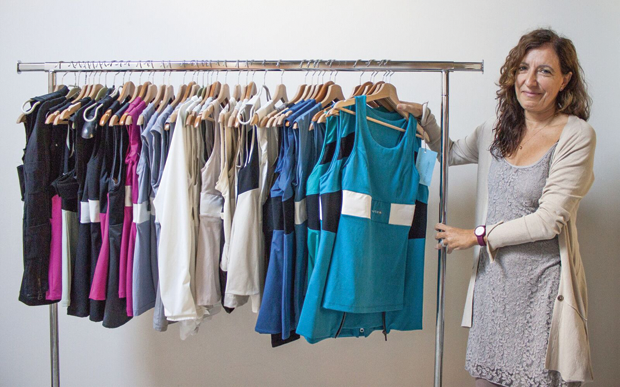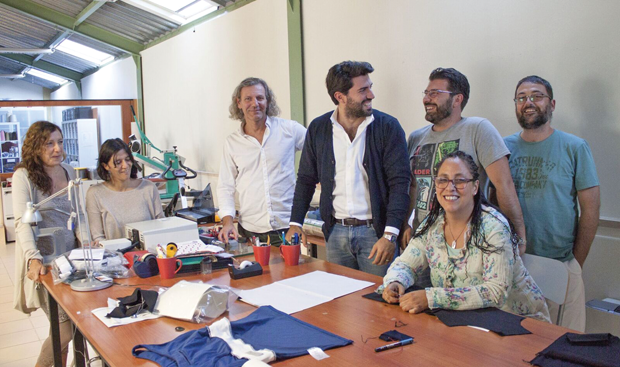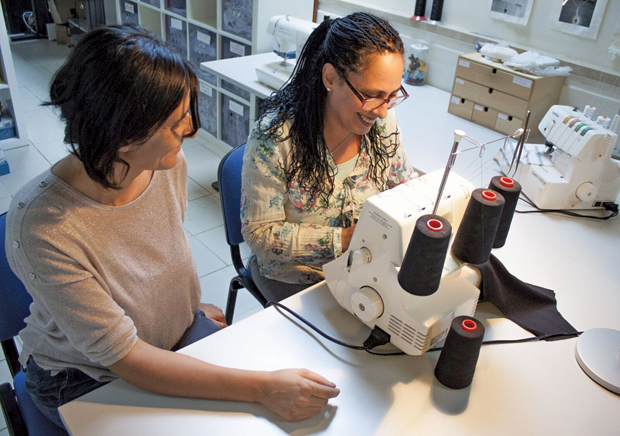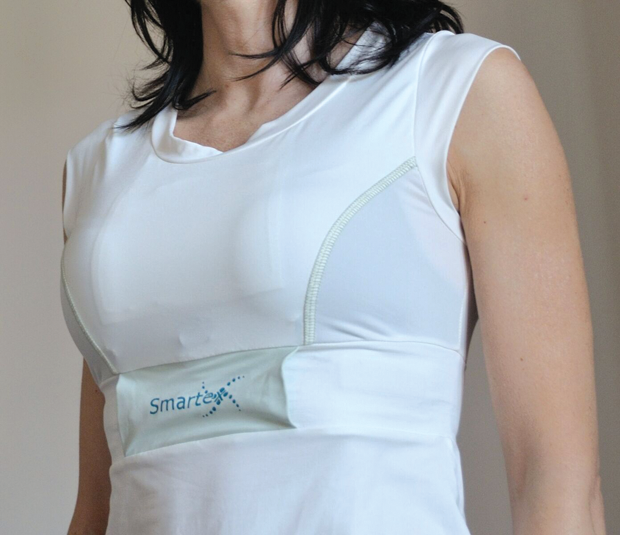As bedtime approaches, take note! Your pajamas may have something important to tell you.
If you’re elderly and susceptible to hypothermia, your pajamas might let you know that your temperature has fallen and you should add some blankets or turn up the heat. If you suffer from chronic obstructive pulmonary disease, then they might let you know that your respiration and pulse rates indicate the possible onset of an attack, giving you time to take preventive medication to avert a trip to the emergency room. If you’ve suffered a stroke, they might help keep track of your rehabilitation. And all this without the need for any sensors or wires attached to your body or to the fabric: in these pajamas, the sensors are part of the cloth itself—unobtrusive and unnoticed.
Envisioning a Health-Sensing Fabric

in Italy. (Photo courtesy of Smartex.)
That’s the vision bioengineer Rita Paradiso (Figure 1) has been pursuing for most of her professional life and a goal coming closer and closer to reality. Smartex, the company she now heads in Pisa, Italy, has already been delivering early versions of health-sensing garments to both clinicians and researchers all across Europe and is carrying out research to refine and expand the fabric’s capabilities (Figure 2). “The technology is ready, and the system is working,” she says.
The possibilities for such smart fabrics, Paradiso continues, are enormous. Besides pajamas, the health-monitoring fabrics have also been used for undershirts but could take almost any form that can provide close but comfortable and natural contact with the skin. “Textile is a more natural interface with the skin” than other kinds of sensors, Paradiso says. Most systems for continuous monitoring of physiological parameters involve electrodes that need to be stuck to the skin with some kind of adhesive or simple wristbands or other devices that can only provide relatively simple and low-fidelity data. “All of our studies are aimed at finding the best compromise between comfort and signal quality,” she explains.

Paradiso’s skills are eclectic. She studied physics, earning her undergraduate degree at the University of Genoa, Italy, and later working in the physics department of Queen Mary College at the University of London during her doctoral work in bioengineering. This was followed by postdoctoral positions in molecular chemistry in Saclay, France, and in material engineering in Trento, Italy. She then worked on the bioactivation of microelectromechanical systems, heading the research department of a technobiochip company. She joined Smartex in 2000 as head of research and development, and, in 2011, she became the company’s chief executive officer (CEO).
Today, she believes that developing clothing that can monitor health enables “a whole new approach to health care. It’s a revolution—for the first time, we can have information continuously in a real situation,” without the distractions or stresses of intrusive sensors or a clinical setting.
Combining Research with Industry Expertise
Her move to research biosensing fabrics came about, in part, as an attempt to bring together academic research and industrial expertise in her home region of Tuscany. “Pisa is a big university center,” she says, and the region is also “a big textile district” with a long history in that industry. When she joined the company to head research, she and her coworkers plunged into “a wedding between smart materials and textiles.”
The basic concept began with simply developing conductive fibers that can be integrated into a fabric at the weaving stage— fibers that maintain flexibility and washability similar to those of the overall fabric. Having worked on molecular electronics in a university setting, she says that, for the first two years on this project, “I was basically going around to visit the [textile] factories, which are mostly quite small, but you can find everything. It’s a district in which you can find many small companies that each hold a piece of the puzzle.”
In the early stages, she remembers, “I had to create a lot of the academic part, because the process to go from the laboratory to industry was too long. So, instead, I used material that was available, to do something different.” For example, at one point, she adopted a process that was used in fashion to create special effects in fabric using different types of fibers, including metallic threads, woven into the cloth itself rather than added later. “The project was very successful,” she says, and made it possible to start getting research funding to continue the work.
Much of the research over the years has centered on finding the optimum number and placement of sensors within the garments and developing the algorithms and software to interpret the signals received and convert them into useful physiological parameters. So far, Paradiso and her team have had success in picking up and interpreting signals that reveal heart rate, respiration rate, electrocardiogram data and information about heart irregularities, body position and activity, stress levels, skin temperature, and the motion of joints and limbs. The shirts Paradiso’s company produces can now be tossed right into the washing machine like any other clothing item. As Paradiso explains, “The sensor is just part of the fabric.”
Potential Uses
The potential uses for such smart garments span a wide swath of both medical and fitness applications, among others. Right now, she says, “This is not a product that is addressing a particular application.” They are mostly being experimented with by researchers who are developing ways to use the data for a variety of potential disease or mental-health monitoring applications.
For example, one research project involving hundreds of patients is looking for signs of secondary effects (such as depression) that occur in association with a primary medical condition. The hope is that, by fitting patients with unobtrusive monitoring systems requiring no particular activation or preparation, the readouts they provide of basic vital sign data at regular intervals can aid in detecting such secondary conditions earlier and making appropriate responses available sooner.
There are many other potential applications for such unobtrusive biosensing undergarments, Paradiso says. One example is real-time monitoring of people working in hazardous situations—firefighters inside a burning building, for example, or soldiers in combat—to provide virtually instant alerts of physical stress or danger, from a sudden spike in heart rate to an interruption of breathing.
“The challenge was developing something that was easy to use, a standard garment, like an ordinary T-shirt, but able to give a good signal with good quality,” she elaborates. “We start with very ambitious ideas, to make something that would provide data similar to what you would get from a clinical device, able to get all the information you might want. But for now we’re doing something a bit more simple, something that people can use right away.” She and her team of scientists and engineers continue to focus on optimizing the configuration of sensors and work with doctors to develop new variations for particular kinds of monitoring (Figure 3). “It’s important to put the sensor as close as possible to the source of the signal you want to measure,” Paradiso explains.

Pajamas with embedded sensors could be useful for a wide variety of monitoring situations. During an invited talk last year at an international conference on the Internet of Things in Lisbon, Portugal, Paradiso outlined several important potential applications for such sleepwear. As populations in many parts of the world are growing older and life expectancies are rising, more and more elderly people will need systems that can provide alerts for changes that might signal health- or even life-threatening conditions. For example, many older people die in their sleep because of hypothermia, she explained in her presentation, but providing a system that can warn of dropping temperature before it reaches a dangerous level is relatively easy with simple temperature sensors properly placed.
Such sleepwear (and, potentially, also different fabric systems such as smart bedsheets) could also provide early warnings of conditions like sleep apnea or other breathing disturbances. And by monitoring movement and position, they could even automatically alert caregivers to a potentially dangerous fall during the night.
One area that Paradiso and her team are actively exploring is potential uses for mental-health monitoring. In a research project called Psyche, they are using personalized wearable systems that monitor movement and cardiopulmonary data as well as other parameters such as voice analysis to try to determine the emotional state of patients with bipolar syndrome.
Ultimately, Paradiso envisions something she calls a Wearable Wellness System (WWS) that would constantly monitor a wide variety of parameters with sufficient distributed sensors to provide robust redundancy and ensure continuous feedback (Figure 4). The various sensors would all connect wirelessly to a central recording and preprocessing device that would then relay relevant data to a central facility. Such systems, for example, might allow patients who would otherwise require monitoring in a clinical setting to go home or to work as usual, with constant monitoring by systems having no visible outward sign and allowing unrestricted, normal movement. Patients recovering from a stroke might be able to go about daily activities, and any indications of a recurrence would be quickly detected; in addition, detailed quantitative data could be provided regarding their progress in terms of activity, range of motion, and so on.

Another area of ongoing research focuses on how to translate the many kinds of data such wearable systems can collect into useful feedback for the user—for example, in the management of chronic disease conditions or even for athletes who want performance-related real-time information about their breathing and heart rate. Particular kinds of garments could easily be tailored, literally, for such specific applications. “This is a platform that can provide a lot of information, but the way that information is presented to the user” is key to making it a real benefit, Paradiso says.
Many Future Possibilities
Looking to the future, she continues, “it’s important to go beyond the first level of processing of the information, to go into more and more interpretation of the data.” As these sensing garments are increasingly worn by people with different medical conditions and in different situations and settings, the data collected could be mined to provide clues for early warning signs of disease or determine circumstances or treatments that could help to ameliorate those conditions. “We’d like to be able to combine the information that is coming in from these data sensors to produce an interpretation that can be provided by a smartphone and provide some advice or education,” she says.
“For people who are living alone, or who need some assistance, or need to be assured that someone is looking after them,” simply having such a system available could provide a greater level of confidence and improved quality of life. For most such uses, Paradiso, explains, “It’s not necessary to have it on for 24 hours. But when they need it, it can be available to check things.”
A Woman Engineer’s Perspective
Paradiso’s multifaceted career, working both as an engineer and as a company CEO, spans areas in which women are relatively underrepresented, something that perhaps gives her a unique view of her industry and her business. “I think the fact that I am a woman probably can, in some way, affect the way in which I was more patient compared to a man in the same position,” she says. “We had moments in the past, and will have situations in the future, where it is not so easy. A woman can be more constant” through the tough times. As a small company that operates “more like a research lab,” focused more on developing the technology than on doing much marketing or manufacturing, Paradiso offers the suggestion that “if I look at it on the research side, the fact that I’m a woman makes me more focused on obtaining some practical results. I never was happy only with doing a demonstration; I was looking for something more stable and reliable. On the other hand, if I look at the business side, maybe I wasn’t aggressive enough, compared to some men,” she goes on.
What appeals to her most, she says, is the inherent multidisciplinary and diverse nature of her work. “It’s so difficult to combine the design part with the technical part, but both are really important if you want a good product… For me, it was stimulating. I like to meet people with different backgrounds, to understand how they work. It’s probably the reason I’m doing it. I like to meet people with different approaches.”



